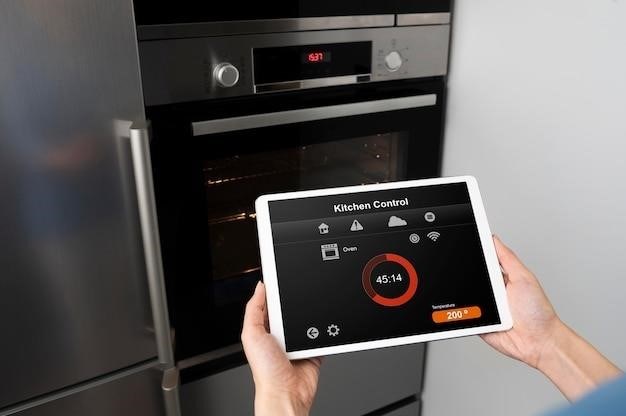Norcold N10DCSSR Refrigerator⁚ A Comprehensive Guide
This guide provides essential information for understanding, installing, operating, and maintaining your Norcold N10DCSSR refrigerator. We cover setup, troubleshooting, and safety, ensuring optimal performance and longevity.
Understanding Your Refrigerator’s Features
The Norcold N10DCSSR offers several key features designed for convenient and efficient operation. The adjustable glass shelves allow you to customize the interior space to accommodate various sized items, maximizing storage capacity. A dedicated crisper drawer maintains optimal humidity for fresh produce, preserving its quality and extending its shelf life. The interior LED lighting provides clear visibility of your stored items, even in low-light conditions. The door features convenient storage compartments for smaller items like condiments and beverages, keeping them readily accessible. The control panel, typically located on the exterior, allows you to easily adjust temperature settings and monitor the refrigerator’s operational status. Understanding the functions of each control is vital for maintaining the desired temperature and preventing potential issues. Note that specific control panel features may vary slightly depending on the manufacturing date of your unit. Always refer to the specific markings and symbols on your control panel for accurate operation. This understanding of your refrigerator’s features will enable you to utilize its capabilities effectively and ensure proper food preservation during your journeys.
Installation and Setup
Proper installation is crucial for optimal performance and longevity of your Norcold N10DCSSR refrigerator. Begin by carefully unpacking the unit and inspecting it for any signs of damage incurred during shipping. Ensure the location you’ve chosen provides adequate ventilation, as insufficient airflow can lead to overheating and reduced efficiency. The refrigerator should be placed on a level surface capable of supporting its weight. Consult the provided leveling instructions to ensure proper stability. Before connecting to power and gas, verify that all connections are secure and free from leaks. Refer to the specific diagrams and instructions included in your manual for detailed guidance on gas line connection; Once the unit is correctly positioned and leveled, you can proceed with connecting it to the power supply, ensuring it’s grounded correctly for safety. After power connection, allow the refrigerator to sit upright for at least 24 hours to allow the refrigerant to settle. This settling period is critical to prevent potential issues with the cooling system. Following this, you can proceed to initial operation, setting the temperature to your desired settings. Remember to refer to your specific model’s manual for detailed diagrams and instructions.
Connecting to Power and Gas
Connecting your Norcold N10DCSSR to both power and gas requires careful attention to detail and adherence to safety regulations. Begin by locating the appropriate power source and ensuring it meets the voltage and amperage requirements specified in your refrigerator’s manual. Use a properly grounded outlet to prevent electrical hazards. Never attempt to connect the refrigerator to an ungrounded or improperly wired outlet. Once the power connection is confirmed, turn off the power before proceeding to the gas connection; Locate the gas supply line and carefully connect it to the refrigerator’s gas inlet, ensuring a tight and secure connection. Use appropriate fittings and sealant as necessary to prevent gas leaks. After connecting the gas line, thoroughly check for any leaks using a soapy water solution. Apply the solution to all connections and look for any bubbling, which indicates a leak. If a leak is detected, immediately disconnect the gas line and address the issue before proceeding. Once you’ve verified the absence of leaks, turn on the gas supply and ignite the pilot light according to the instructions provided in your manual. Always prioritize safety and consult a qualified technician if you are unsure about any aspect of the installation or if you detect a gas leak.

Initial Operation and Temperature Settings
After successfully connecting your Norcold N10DCSSR to both power and gas, and verifying the absence of any leaks, you can proceed to initial operation. Before loading any food, allow the refrigerator to run for at least 24 hours to reach its optimal operating temperature. This allows the internal components to stabilize and ensures even cooling throughout the unit. During this initial run period, monitor the temperature using the internal thermometer, which is typically located inside the refrigerator compartment. Adjust the temperature settings using the control panel according to your preferences. The Norcold N10DCSSR usually offers adjustable temperature settings, allowing you to fine-tune the cooling to your specific needs. Remember that the optimal temperature range for food preservation is typically between 35°F and 38°F (1.7°C and 3.3°C). Avoid setting the temperature too low, as this can lead to excessive energy consumption and potentially damage the compressor. Once the refrigerator has reached the desired temperature and the initial run period is complete, you can then start loading your food items. Ensure that the food is properly packaged and stored to maintain freshness and prevent spoilage. Refer to the food storage recommendations provided in your refrigerator’s manual for best results.

Regular Maintenance and Cleaning
Regular maintenance is crucial for ensuring the longevity and efficient operation of your Norcold N10DCSSR refrigerator. Begin by cleaning the interior regularly, at least once a month. Remove all food items and shelves, then wipe down the interior surfaces with a mild detergent solution and a soft cloth. Rinse thoroughly with clean water and dry completely before replacing the shelves and food. Pay close attention to any spills or leaks, cleaning them promptly to prevent the growth of mold or bacteria. For exterior cleaning, use a damp cloth to wipe down the exterior surfaces, avoiding harsh chemicals or abrasive cleaners. Inspect the door seals regularly to ensure they are clean and free from debris, as compromised seals can lead to inefficient cooling and increased energy consumption. Also, check the condenser coils, located at the rear or bottom of the refrigerator. These coils can accumulate dust and debris over time, reducing cooling efficiency. Clean the coils using a brush or vacuum cleaner to remove any dust or obstructions. This should be done at least twice a year, or more frequently in dusty environments. Finally, it’s recommended to inspect the gas lines annually (if applicable) for leaks and ensure proper ventilation around the refrigerator to prevent overheating. Following these simple maintenance steps will significantly extend the life of your Norcold N10DCSSR and ensure optimal performance.
Troubleshooting Common Issues
This section addresses common problems encountered with the Norcold N10DCSSR refrigerator. If your refrigerator isn’t cooling properly, first check the power supply. Ensure the refrigerator is plugged in securely and the circuit breaker hasn’t tripped. Verify that the gas supply is correctly connected and functioning if it’s a gas-powered model. Inspect the door seals for any damage or debris that might impede proper sealing, leading to heat loss. A faulty thermostat can also cause cooling issues; test its functionality or consider replacement. If the refrigerator is making unusual noises, such as loud humming or clicking, this could indicate a problem with the compressor or other internal components. Excessive vibration can also be a symptom of a problem and should be investigated. Check the condenser coils for excessive dust build-up; cleaning them can resolve cooling problems. If the refrigerator is excessively cold, check the temperature settings. Adjust accordingly to achieve the desired temperature range. If the problem persists after these checks, refer to the advanced troubleshooting section or contact a qualified technician. Remember to always disconnect the power before attempting any internal repairs. Incorrect temperature settings can also lead to issues, so ensure you understand how to adjust them correctly. Ignoring minor problems can lead to bigger, costlier issues later, so prompt attention to unusual sounds or performance is key.
Addressing Specific Problems (e.g., No Cooling)
Let’s tackle specific issues you might encounter with your Norcold N10DCSSR refrigerator. If you’re experiencing a complete lack of cooling, systematically check the power supply. Ensure the refrigerator is securely plugged into a functioning outlet and that the circuit breaker hasn’t tripped. If the refrigerator runs on gas, verify the gas supply is properly connected and the gas valve is open. Inspect the gas lines for any leaks or blockages. Examine the internal fan; a malfunctioning fan can prevent adequate cold air circulation. Check the condenser coils for ice or excessive dust accumulation. Clean these coils thoroughly to improve cooling efficiency. A faulty compressor is a common cause of no cooling; this requires professional attention. A malfunctioning thermostat can also be the culprit; check its settings and potentially consider a replacement. Inspect the door seals; damaged seals allow warm air to enter, hindering cooling. If the problem persists despite these checks, there might be a refrigerant leak, requiring specialized repair. Remember to always disconnect power before attempting any internal inspection or cleaning. Improper handling of refrigerant can be dangerous. If you lack the expertise or comfort level with this type of repair, it is crucial to contact a qualified appliance technician.
Advanced Troubleshooting and Repairs
This section delves into more complex troubleshooting and repair procedures for your Norcold N10DCSSR refrigerator. Addressing issues like intermittent cooling or inconsistent temperatures often requires a deeper understanding of the system’s components. Diagnosing problems with the control board, which manages various functions, can be challenging and often requires specialized tools and knowledge. Testing the control board’s functionality may necessitate using a multimeter to measure voltage and resistance at different points within the circuit. Incorrect readings can indicate a faulty component needing replacement. Similarly, diagnosing problems with the compressor requires specialized equipment and expertise. Checking compressor windings for continuity or shorts requires a multimeter. A faulty compressor typically needs professional replacement due to the complexity of this task and the potential risks involved in handling refrigerants. Working with the refrigeration system’s components, including the evaporator and condenser, should only be undertaken by trained technicians. These components handle refrigerant under pressure, posing potential safety risks if improperly handled. Incorrect handling of the refrigerant can lead to serious injury or environmental damage. Always prioritize safety and refer to the manufacturer’s service manual for detailed diagrams and specifications before attempting advanced repairs. If you lack the appropriate tools, skills, or training, contact a qualified appliance repair professional for assistance. Attempting advanced repairs without proper expertise can lead to further damage or safety hazards.
Safety Precautions and Warnings
Operating your Norcold N10DCSSR refrigerator safely is paramount. Always ensure adequate ventilation around the unit to prevent overheating. Never obstruct the vents or place flammable materials near the appliance. Regularly inspect the power cord for any signs of damage, such as fraying or cracks. A damaged cord poses a significant fire hazard and should be replaced immediately by a qualified technician. When cleaning the interior, unplug the refrigerator from the power source to avoid electrical shock. Use only mild, non-abrasive cleaners and avoid harsh chemicals that could damage the surfaces. Never attempt to repair the refrigerator yourself unless you possess the necessary expertise and training. Improper repairs can lead to serious injury or further damage to the appliance. Always refer to the manufacturer’s service manual for detailed safety guidelines. The use of flammable materials or aerosols near the appliance is strictly prohibited. Be cautious when handling the refrigerator’s components, as some parts may be sharp or have exposed electrical connections. If you smell gas, immediately turn off the gas supply and contact a qualified technician. Never operate the refrigerator if you suspect a gas leak. Proper ventilation is critical, especially in enclosed spaces. Ensure the area around the refrigerator is well-ventilated to prevent the build-up of flammable gases. Always supervise children around the appliance to prevent accidents.
Where to Find Additional Resources
For comprehensive support and further assistance with your Norcold N10DCSSR refrigerator, several resources are available. The official Norcold website provides detailed product specifications, user manuals (often downloadable as PDFs), troubleshooting guides, and frequently asked questions (FAQs). Their website also includes a searchable database for parts and accessories, making replacements convenient. You can also access helpful videos and tutorials demonstrating various aspects of refrigerator operation and maintenance. Consider contacting Norcold’s customer service department directly for personalized assistance. They can provide technical support, address specific queries, and guide you through complex issues. Many online forums and communities dedicated to RV appliances and repairs offer valuable insights and user experiences. These platforms often feature discussions on troubleshooting common problems and sharing repair tips. Local RV dealers and service centers are another valuable source of support. They can provide in-person assistance, diagnostics, and repairs. Remember to always verify the credentials and reputation of any third-party service provider before engaging their services. Consult your refrigerator’s warranty documentation to understand the terms and conditions of coverage. This will help you determine what repairs are covered and how to proceed with warranty claims. These combined resources provide a comprehensive network of support for your Norcold N10DCSSR refrigerator.
























